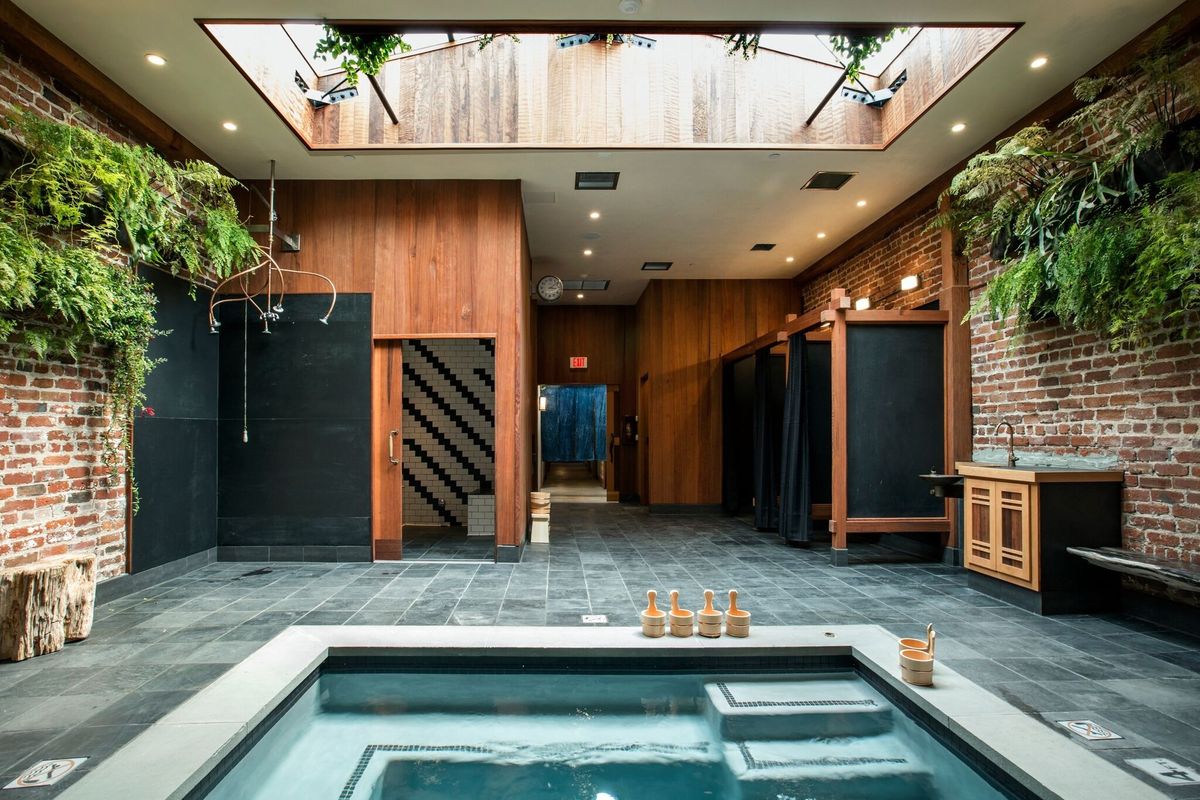Onsen, the Tenderloin's new Japanese-inspired bathhouse, opened last Friday, after a three-year buildout by co-owners Sonny Simmons and his wife Caroline Smith. Formerly an auto-body shop, the couple gutted and retrofitted the structure, yet kept its character, preserving its brick walls and exposed beams. The former mechanic's pit was re-envisioned as a soaking pool. "This place was just begging to be a bathhouse," says Simmons, a longtime general contractor.
The conversion was not without its hiccups. More than halfway through the renovation, Simmons and Smith discovered the building wasn't zoned to offer massage. Undeterred and drawing on her Zen powers to navigate the city's permit process, Smith, an artist and acupuncturist, reached out to Supervisor Jane Kim for help. The provision blocking their permit was established to curb prostitution in the Tenderloin (Onsen is located at Hyde and Eddy streets). The couple's holistic intentions were enough to persuade Kim that Onsen wouldn't be that kind of illicit establishment and last December, City Hall amended the original provision, allowing the project to move forward. (Onsen joins a wave of new businesses in the Tenderloin. On the same block is the newly opened jazz supper club, Black Cat. Nearby is former Vogue editor Emily Holt's Hero Shop; The Saratoga, a new restaurant by Bacchus Management Group (Spruce, Woodside Tavern, Pizza Antica); In Fiore botanical skincare boutique on Post Street; and barbershop The Joint on Larkin.)

The onsen is located at the back of the building, through a hallway lined by massage and acupuncture rooms marked by handcrafted shoji doors. A neat row of bamboo lines one side of the 10-person pool, while another wall features a vertical garden of staghorn and sword ferns. A frosted skylight above gives the effect of moonlight, because such flattering illumination is helpful when bathing among strangers.
"We wanted to create a the feeling of a place that you never knew existed, but had an ancient appeal," says Simmons.

The tea room is located at the front of the building. Simmons' affinity for the organic minimalism of Japanese design is beautifully expressed here in the clean lines, ample volumes, and natural materials. Reclaimed redwood from Simmons' personal collection was used for the cabinetry, tables, and bench seating—the last is a live-edge piece sawn from a log that Simmons found in the Russian River after a rain storm. Walls are made of American Clay, which lends softness and texture to the space. Natural slate—aka chalkboard—was reclaimed from schools around the country and used for the tabletops, where the deep-black tone provides a dramatic backdrop for the elevated Japanese cuisine from chef George Meza, formerly of Terra in Napa and Ame at San Francisco's St. Regis Hotel.
The menu, simply divided into four (bites, skewers, plates, and sweets), guides diners toward a four-course meal that's inventive, ever-changing with the seasons and farmers-market offerings, and totally satisfying. Now that fall is upon us, start with a small bowl of warm rice porridge, elevated with miso kimchi, which provides brightness, and an unctuous soft-boiled quail egg, its striking magenta hue from acquired from a beet-pickling brine.

We recommend ordering two or more of the hibachi-fired skewers for variety's sake; on our visit, our mix-and-match selection included boneless chicken wings sprinkled with lacto-mushroom salt and lemon (it gets our vote for the most flavorful grilled chicken ever) and trout belly, a fatty delight with crispy skin—chopsticks down, this was our favorite bite of the night.
We enjoyed the warm udon as our main dish. Served without the broth, it's more of an elegant noodle salad composed with egg yolk, shaved raw Brussels sprouts, and a generous serving of glistening orange trout roe, which gives the dish its saltiness and its beauty. A preserved Asian pear, covered in a glossy and gooey black sesame paste, was the thrilling culmination of such a poetic and thoughtful meal; the savoriness of the thick paste lightened by the sweet fruit and emboldened by the surprise of chocolate ganache hidden under the dark dome.

The tea room's drink menu is equally as considered as the food, providing tasting notes on par with wine descriptions. The Qilan Dark oolong tea from China, for instance, is redolent of cinnamon, dried plums and cedar, while the houjicha from Japan is reminiscent of buttered toast and caramel. A tightly curated sake list is also highly descriptive to help curious imbibers decide on a potion. Craving something "with the aroma of spring flowers"? Go for the Sequoia Junmai Genshu, made in in SF. The Rihaku Nigori Tokubetsu Junmai seems easily palatable for sake novices with its "sweet rice and slightly fruity" flavors, although its nickname goes a long way to help the selection process—who doesn't want to drink "Dreamy Clouds"?
// Onsen is located on 466 Eddy Street. Bathing schedules are as follows: Sunday, Tuesday, and Wednesday from 10am - 10pm are women only (bathing suit optional); Thursday and Friday from 10am-10pm are coed (bathing suit required); and Saturday from 10am - 1am is coed (bathing suit required). Onsen is closed on Mondays, onsensf.com





















